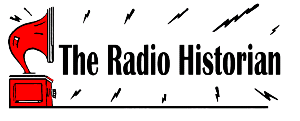|
www.theradiohistorian.org
Copyright
2020 - John F. Schneider
& Associates, LLC
[Return
to Home Page]
(Click
on photos to enlarge)
Doc Herrold operating the arc-fone station, about 1912
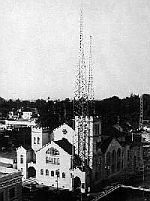
KQW towers on the First Baptist Church, San Jose, 1925
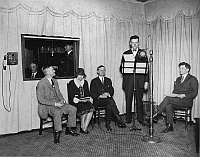
The broadcast of a program from the First Baptist Church
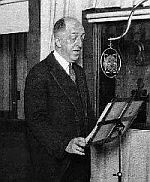
Charles Herrold on the air at KQW, 1925
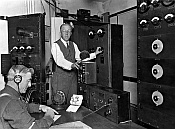
Charles Herrold operates the KQW transmitter at the First Baptist
Church, about 1926.
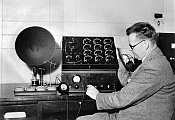
KQW owner Fred J. Hart, 1932
|
|
In the early years of the present century, we began to hear
strange and almost weird tales concerning the work of Vladimir Poulson, Count
Arco, Majorama, Collins, and others, in the transmission of voice and music
through the mysterious medium of wireless, but there was one of whom little was
heard, but who was working quietly in his laboratory in San Jose, and that one
was Charles D. Herrold, experimenter and inventor.
Mr. Herrold, or “ Doc” as he is known to his
friends, watched these early experimented, duplicating and even exceeding their
efforts, but refraining from publicity.
In 1909, however, Herrold
constructed a huge “carpet” aerial containing over 11,500 feet of bronze wire and suspended it between two
seven story buildings in San Jose, and immediately he began establishing world
records for both telegraph and telephone communication.
Mr. Herrold’s operator during this period
beginning with 1909 was Mr. Ray Newby, then living in San Jose.
And later Mr. E.A. Portal and Mr. Frank Schmidt joined the company.
The October 1910 issue of the
magazine first issued by Hugo Gernsbach as an amateur publication mentions this carpet aerial
constructed by Mr. Herrold. The attention of residents
of San Jose was first drawn to the work of Mr. Herrold in 1909 by reason of the
spectacular appearance of the huge aerial in the downtown district. The early work of Dr. Herrold in what was
later to become radio station KQW was carried on under a variety of names – The
Herrold Laboratories, the National Wireless Telephone and Telegraph Co., and
others. A message received by Dr.
Herrold in September 1913 from the Bremerton Naval Radio Station stated that
the record “Trail of the Lonesome Pine” came in extra good.
In 1912, two-way communication by voice with occasional
presentation of music was established between the Garden City Bank Building in
San Jose and the Fairmont Hotel in San Francisco. This
was undoubtedly the first two-way voice broadcast by radio.
Immediately after the International Radio-Telegraph
Convention in 1912, Dr. Herrold applied for and received a license under the
new act, and from that time on he was never without a license to operate the
radio station except during the war period, when he was instructor.
In 1912, with the cooperation of the Wiley B. Allen music
store in San Jose, the first receiving studio in the world was
established. It consisted of two master receiving
sets and two dozen pairs of telephone receivers hanging around the walls with
chairs arranged for the comfort of the guests. Contrast
this with the modern high-fidelity loud speaking systems of
today. In 1915, Lt. Ellery Stone, U.S.
Radio Inspector at that time, came to San Jose and suggested to Dr. Herrold
that he broadcast music for the Panama-Pacific International Exposition
(The World’s Fair) in San Francisco. The plan
was immediately adopted and during the exposition a daily program of from six
to eight hours presentation was given. The
first broadcast was received at the foot of the Tower of Jewels on
the exposition grounds by Dr. Herrold himself, in company with Mr. Ford
King. The only station identification
made in those days was “This is the wireless telephone on the Garden City Bank
Building in San Jose, California”. It
was the only one in regular operation in the world.
After the Panama-Pacific
Exposition, Dr. Herrold continued his daily broadcasts, both with the original apparatus and with
equipment which he improved and invented from time to time. Entry
of the United States into the World War, and the consequent censorship of all radio transmitting and receiving sets, forced a
temporary suspension of experimentation and broadcasting.
Immediately after the close of the war, work was resumed
under a number of licenses and with various wavelengths and power. One license was variable from 150 to 25,000
meters, with another variable to 1,000 watts in power.
The call letters KQW were first assigned on
December 9, 1921, and were used on the transmitter that had been in operation
broadcasting entertainment for over ten years previously.
It is interesting to note that the first
license issued under the KQW letters was granted for 360 meters with no power
specified.
During 1922, 1923, and 1924, the entertainment broadcasts
were continued. In 1925, Dr. Herrold
felt that he could no longer carry the burden of broadcasting and decided to dispose
of his license so that he might devote his time to other activities in radio
work. At about this same time, in the
early spring of 1925, Dr. William Keeny Towner, the pastor of the First Baptist
Church in San Jose, California, conceived the idea of the church building a
radio station. Dr. Towner, being a man
of action, immediately brought the matter to the attention of the
church. The church gave its approval, and immediately
plans were started to this end.
The writer (Harry Saine), being a very good friend of Dr.
Towner, a member of the church, an electrical engineer, and having had a vast
experience in voice transmission in connection with his four years as
superintendent of the Hoopeston Telephone Co. at Hoopeston, Illinois, was chosen
by Dr. Towner on his qualifications to work with him to the end that license be
obtained and a station be built, but the sailing was not clear or easy. We learned that Dr. Herrold had a license,
but did not know that he wanted to dispose of it. We
tried to contact Dr. Herrold, but for some
reason or another we were unable to do so for some three or four weeks. At last, I got an audience with him, only to
learn that he had given a thirty-day option to another group only a few days
before, and had turned over to them his old license.
Things looked bad, for we knew that the
government would not grant two licenses for this community. Dr. Herrold was very favorable to the First
Baptist Church, but his hands were tied. But the group who had obtained the option was a civic
organization, and did not desire to use the license themselves, but wanted to see that something
substantial and definite was done, to the end that San Jose would have a radio
station of which it would be proud.
There followed three weeks of negotiations – three weeks in
which meeting after meeting was held, and in which I was trying to show the
civic organization that the First Baptist Church was the one that should be
given this opportunity. There were others after this license, but I believe the Lord was on our side, for the day
before their option expired, it was turned over to us, and inasmuch as the
acceptance had to be made in person, we immediately got in touch with Dr.
Herrold, and he signed it over to the First Baptist Church. In May 1925, Dr.
Towner, Frank Curtis and Harry Saine went to San Francisco and got the consent
of Col. Dillon (then Radio Inspector for this district) so that the First
Baptist Church could take over Dr. Herrold’s license and operate on a power of
500 watts on 231 meters.
The license was ours, but a big job was ahead – that of
raising $20,000 with which to put the station in, so a general meeting of the
church was called for that purpose. Frank Isenberger had change, and he caused to be erected
on the pulpit two towers to represent the radio towers, with ribbons from one tower to the
other as the aerial. Then pledges were
called for and, as they were given, the totals were added at regular intervals
and placed on one of the towers – beginning at the bottom and going up towards
the top. When that meeting adjourned,
the top figure on the tower showed more than $20,000 in pledges.
With the money pledged, we could then go ahead and contract
for the equipment. This was done by
purchasing a new Western Electric 500-watt transmitter.
The towers were furnished and erected by the
Pacific Coast Steel Company. The excavation
for the bases and the setting of the steel stubs in cement was supervised by
Guy Lunty. Each base contains
approximately sixteen tons of cement. The
front entrance of the church was torn away and, after the front
tower was erected, the front was rebuilt around it.
Two legs of the back tower went up through
the church, and the other two set in a strip of land back of the church and
owned by the church. These towers were
150 feet high and had a steel flag pole 10 feet long on top of each tower,
making the top of the flag poles 160 feet above ground.
Most of the labor for the installation was donated by
members of the church, and supervised by Harry Saine.
There is a box sealed in the southwest leg of
the front tower in which is a record of the radio station, and, although Harry
Saine was one of those most instrumental in obtaining the license for the
church and the installation of the equipment, yet his name was for some unknown
reason left out of the list of those to whom credit was given.
On Saturday night at 7:30 PM, December 5, 1925, the station
went on the air on a wavelength of 231 meters.
On January 15, 1926, Fred J. Hart took over the control and
operation of KQW. Mr. Hart was very successful
in bringing the station to the front as an agricultural station, and, on
January 14, 1930, Mr. Hart was given an option to purchase from the First
Baptist Church the radio station and all equipment.
This option was consummated, and a bill of
sale signed March 31, 1930, under the name of the Pacific Agricultural
Foundation, Ltd. The church was paid a
specific sum of money, the payment of which was spread over a number of
years. In addition to the money
consideration, the church received, free of cost, the broadcasting of religious
services once each week on Sunday. The
broadcasting, however, could not exceed 5 hours per Sunday.
Thus, although the work was carried on under many different
call letters, wavelengths and powers, the entire period of programs from 1909
was one continuous effort of the same radio station now known as KQW – and it
is on this that KQW grounds its claim as the pioneer broadcasting station of
the world. It was also the first station
to broadcast continuous entertainment, as witness the San Jose-Fairmont Hotel
two-way broadcasts for eight months in 1912, and the Panama-Pacific Exposition
continuous broadcasts of 1915, with no interruptions of programs since that
time except during the World War.
|
